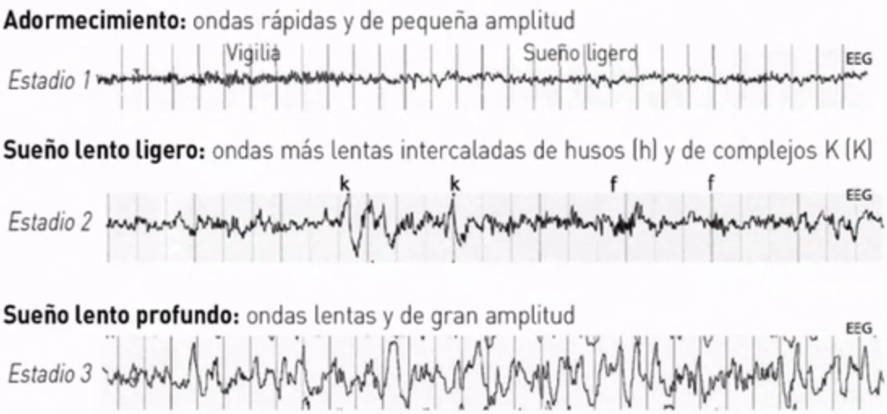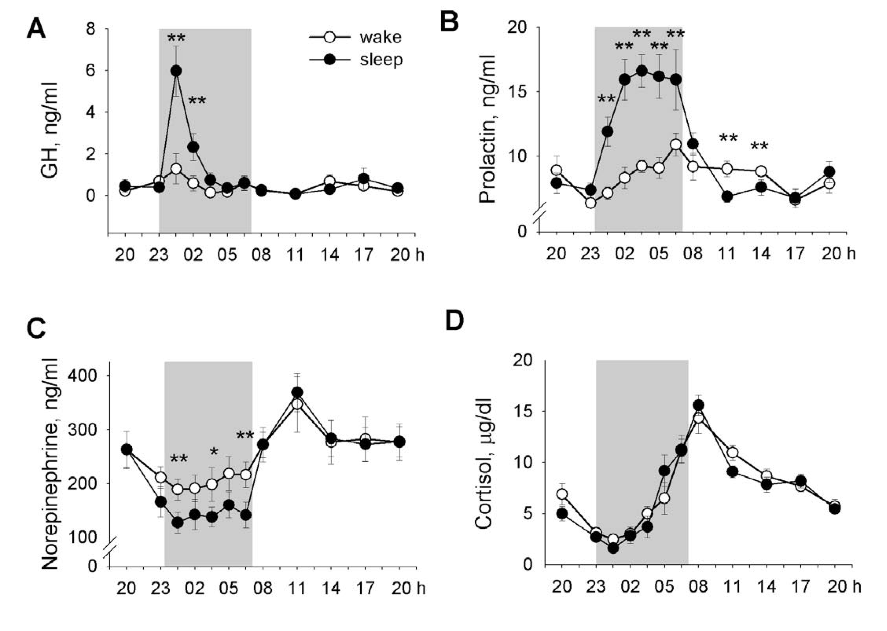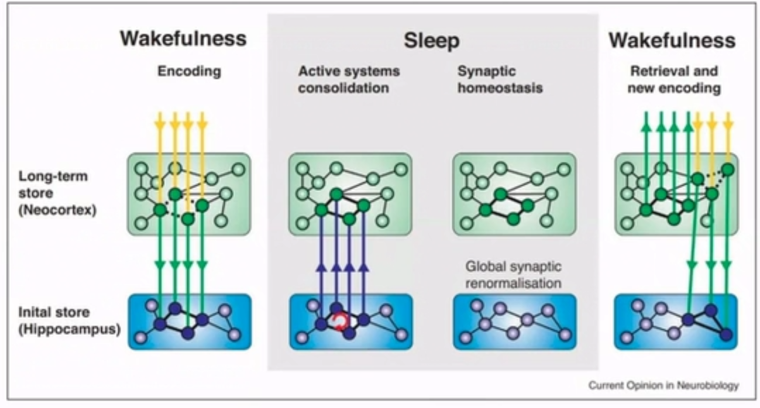What is sleep?
We can define sleep as a basic natural biological need. It is self-regulated by the nervous system (specifically by the reticular activation system) and can be reversed (it has a beginning and an end).
When we are asleep, voluntary motor activity is reduced, our response to stimuli decreases and we tend to maintain a certain posture.
Is sleep the same throughout the night?
It has been demonstrated that during sleep different processes occur at the cerebral level, the best known and studied are those derived from “polysomnography”.
Polysomnography is a test that is performed when we are asleep and records:
- Eye movements: by electrooculogram (EOG).
- Body movements: electromyogram (EMG).
- Brain activity: electroencephalogram (EEG).
- Blood oxygen levels.
- Heart and respiratory rate.
Based on the first 3 parameters we can draw interesting conclusions about the phases of sleep.
Brain waves
When we talk about brain waves we refer to the electrical impulses that our brain cells (neurons) use to communicate with each other.
In order to measure these waves we use the EEG which records the electrical activity of the brain by placing sensors on the scalp. The unit of measurement is cycles per second (Hertz, Hz).
When we are awake (wakefulness) we emit certain types of waves and as we progress in sleep our brain emits different patterns of waves.
WAVES WHEN WE ARE AWAKE
During wakefulness our brain emits Alpha waves, Beta waves and Gamma waves.
- Alpha (8-12 Hz)
Relaxation, less muscle tone.
Boundary from wakefulness to sleep.
Slower eye movements.
It usually occurs in quiet moments and with eyes closed.
It is called quiet vigil.
Interesting fact: People who practice mindfulness or meditation, emit a greater pattern of alpha waves than people who do not practice it and this can be correlated with greater brain control in stressful situations. That is, people who practice mindfulness will react in a calmer way or have greater control over their response than a person who does not. - Beta (12-30 Hz). They are those of alertness and concentration. I will talk about them later.
- Gamma (25-100 Hz / 40 Hz habitualmente). High performance.
*The neurofeedback technique is used to train the control of brain waves while awake.
WAVES AND SLEEP NOT REM
REM stands for “Rapid Eye Movement”, i.e., this is one of the phases of sleep in which there are no rapid eye movements (No-REM).
During the No-REM phase the brain switches from emitting Alpha waves (quiet wakefulness) to Theta waves (3.5-7.5 Hz) with higher amplitude and lower frequency indicating deep relaxation.
Then we would move on to the deeper phases of Non-REM sleep where we would find ourselves emitting Delta waves (1-3 Hz) with greater amplitude and even lower frequency.
In this phase there is a decrease in physiological activity in general:
- Blood pressure is reduced.
- Decreases heart and respiratory rate.
- Lowers body temperature.
- The basal metabolic rate is reduced.
- Lowers muscle tone.
- Eye movements are reduced.

PHASES OF NON-REM SLEEP
Non-REM sleep can be divided into 3 or 4 phases:
- First phase of Non-REM sleep (Numbness): It is when you are falling asleep, Alpha waves are replaced by Theta waves. There is a greater synchrony in the electroencephalogram (waves of greater amplitude and lower frequency).
- Second phase of Non-REM sleep (light sleep): the perception of the environment decreases, theta waves continue to be generated. Sleep spindles appear, which are waves of high frequency and low amplitude between the theta waves, neuronal groups are synchronized at the thalamic level. At the muscular level, periods of spontaneous activity are combined with periods of relaxation. For example, I don’t know if it has ever happened to you, it would be when you are falling asleep and you have a spasm.
- Third and/or third and fourth phase (deep sleep or delta sleep): delta brain waves appear, which are the slowest waves found in the EEG, this is when the physiological variables mentioned above decrease the most.
WAVES DURING SLEEP REM

REM refers to that phase of sleep in which rapid eye movements (REM) occur.
During REM your brain emits Theta waves, Beta waves, and Ponto-Geniculo-Occipital waves (PGO) that are simultaneous with eye movements.
REM sleep is also known as paradoxical sleep, because during REM sleep the brain waves are again very similar to the Beta waves of wakefulness, but our body is paralyzed, there is a muscular atony. Paradox: we have an alert brain in a paralyzed body.
In REM we find two types of signs:
- Tonic signs (we will find them continuously):
- Muscle atony (small spasms may occur).
- Desynchronized EEG (the brain is very active, it is in Beta waves).
- Phasic signs (found sporadically):
- Myoclonus.
- Rapid eye movements (large amplitude and speed to the side with repetitive components).
- PGO waves (simultaneous to eye movements).
- Theta waves.
- Instability of heart rate, respiratory rate and blood pressure.
- Penile erection and clitoral swelling.
Changes in organ and systemic activity
In the autonomic nervous system: increased sympathetic activity.
In the neuromuscular system: muscular atony.
Respiratory system: muscular atony increases upper airway resistance and irregular breathing patterns are generated (phasic).
Cardiovascular system: episodes of brady-tachycardia.
THE HYPNOGRAM

This graph is called a hypnogram and represents the phase changes.
A cycle is a Non-REM phase + a REM phase. It usually lasts about 90-120 minutes. The cycles that occur depend on each person and the hours they sleep, usually between 4-5 cycles.
Green color indicates deep sleep (Phases 3-4 of non-REM sleep).
Blue color indicates the REM sleep phase, the dreaming phase: it is the phase in which dreams are remembered more vividly. We have clearer dreams in our memory and depending on the moment we wake up we can remember them better or worse.
Phase I is not repeated throughout the night, as it only happens to help us reach the deepest sleep.
Phase II of non-REM is the phase we are in the most, since it is a transitional phase towards deep sleep and REM.
If you notice we can also see that the deepest phases of sleep (Non-REM 3 and 4) occur during the first few sleep cycles. Then more REM cycles begin to predominate.
It is normal to wake up in REM. It is normal to wake up at night, we can wake up because our brain can be activated between 20 and 30 times (normal in a polysomnography), we will not remember the awakenings if we do not have the need to go to the toilet or it is more difficult for us to fall asleep.
What is sleep for?
There is research showing that has a major implication in:
- Regulation of the immune system.
- Hormone secretion.
- Regulation of metabolism.
Findings on the immune system
It has been demonstrated in several studies [1] that when we sleep little we become more vulnerable to infections, here are some examples:
- It was demonstrated in a study [2] that people who slept less were more likely to develop the common cold (due to rhinovirus) than those who slept more.

Specifically in this study they concluded that those who slept 7 hours or less showed up to 3 times more risk of developing a cold than those who slept more than 8 hours.
- There is also a very interesting research with vaccines, specifically with the hepatitis A vaccine. They took a group of volunteers and vaccinated them, one of the groups was allowed to sleep as many hours as they wanted and the other group was deprived of sleep the night after the vaccination.
The sleep-deprived people had developed far fewer antibodies than those who slept normally. [3], [4]
- Another study with similar conclusions but with hepatitis B vaccination. [5]
Hormone secretion
To better understand hormone secretion, it is essential to understand that the sleep-wake cycle obeys circadian rhythms (if you are interested, ask me to write about it, I am not doing it so as not to extend), the cycle lasts approximately 24 hours. Most physiological processes are subject to these biological rhythms. This includes hormone release, there are hormones that are released when we sleep and enter a particular phase of sleep:

Interpretation of the graph [6]
- The gray stripe in the graph is the hours of sleep.
- White spots represent a person who does not sleep.
- Black spots represent a person who is sleeping.
A Growth hormone (GH) is released during the first cycles of sleep, which is when we enter deep sleep. Growth hormone, apart from its function in the growth stages, is also regenerative in adults and is a pro-inflammatory substance related to the immune response.
B Prolactin release increases throughout the night and decreases upon awakening. If we do not sleep, prolactin levels are barely elevated, which is important because prolactin is involved in the adaptive immune response.
C Reduced levels of norepinephrine during sleep correlate with improved levels of defensive cells, specifically NK and monocytes (CD14, CD16).
D Cortisol has to decrease for us to fall asleep and there is a cortisol spike at or before awakening that is supposed to help us wake up more energetic. The cortisol rhythm is not altered too much whether we fall asleep or not.
Practical example:
When we are vaccinated we need an inflammatory response to develop immunity to that virus. The release during sleep of growth hormone (GH), prolactin and leptin, generate an adaptive immune response by activating immune cells promoting their proliferation, differentiation and production of proinflammatory substances such as interleukins (IL-1, IL-12), tumor necrosis factor TNF-α, and Th1 lymphocyte cytokines such as interferon-γ. [1]
Metabolism regulation
It has been proven that not sleeping is fattening. Many times when you go on a diet the important thing is to measure sleep, since the success of these diets depends on many factors, but it is also important the time and its quality.
Specifically, you can observe that during sleep the levels of ghrelin and leptin are regulated.
- Ghrelin: hunger hormone.
- Leptin: satiety hormone.
When a person has enough sleep the levels of ghrelin and leptin are normal, but when we sleep little these levels are altered, because there is more ghrelin and less leptin release. [7]
Another study related to sleep deprivation concludes that people who slept less chose much larger portions of less healthy food. [8]
MAIN FUNCTIONS OF SLEEP
- Restorative function of the brain: throughout the day, our brain accumulates certain substances that are toxic to it and interfere with normal neuronal functioning. Among them the most important is beta-amyloid, which has to be eliminated during sleep, this function is performed properly because during sleep the interstitial space between brain cells increases, it has been shown that there is a relative increase of 60% of the total brain volume (compared to wakefulness the intercellular space is 13-15% and during sleep 22-24%). Therefore, in this way the flow of cerebrospinal fluid can eliminate toxic substances more easily. [9], [10], [11]
- Memory function: reinforced synapses are consolidated and those that have not achieved a given action potential are erased. Therefore, forgetting and remembering is an active process. [12]
Graph of memory consolidation during sleep [13]

The green squares represent the cerebral cortex.
Blue squares epresent the hippocampus, which is in charge of memory consolidation.
The yellow arrows represent the flow of information from the cerebral cortex to the hippocampus.
Green arrows represent the integration and learning of information in the hippocampus.
The red arrow represents the information we have been receiving during the day that is replayed and sent to the cerebral cortex. At this point is where the synaptic reinforcement of information storage occurs in the neocortex, mainly during the No-REM phase during the slow wave stages (3-4).
Precisely the blue arrows indicate this consolidation of neuronal memory. When we wake up, we will have an easier time remembering those synapses that have been consolidated during sleep.
Another process that occurs is global synaptic renormalization. It involves the deletion or elimination of not very relevant synapses, which we do not need to keep.
If you are interested in information related to the immune system, I recommend you read my article about the omega 3.
I hope you liked the article and were able to learn and/or better understand what sleep implies for us. I could write many more things about this, if you are interested in a specific one let me know. To finish I leave you the reference of a scale that you can look up and that helps to measure the quality of sleep, it is called the Pittsburgh scale.
Links of interest
- https://www.ncbi.nlm.nih.gov/pmc/articles/PMC3256323/
- https://www.ncbi.nlm.nih.gov/pmc/articles/PMC2629403/
- https://pubmed.ncbi.nlm.nih.gov/14508028/
- https://pubmed.ncbi.nlm.nih.gov/21632713/
- https://www.ncbi.nlm.nih.gov/pmc/articles/PMC3397812/
- https://academic.oup.com
- https://www.ncbi.nlm.nih.gov/pmc/articles/PMC535701/
- https://www.ncbi.nlm.nih.gov/pmc/articles/PMC4642416/
- https://www.ncbi.nlm.nih.gov/pmc/articles/PMC3880190/
- https://www.medigraphic.com/pdfs/revmexneu/rmn-2009/rmn094f.pdf
- https://www.ncbi.nlm.nih.gov/pmc/articles/PMC3507109/
- https://www.ncbi.nlm.nih.gov/pmc/articles/PMC3278619/
- https://www.sciencedirect.com/science/article/abs/pii/S0959438816301726?via%3Dihub




Leave a Reply
Want to join the discussion?Feel free to contribute!